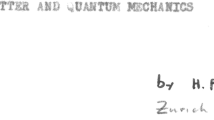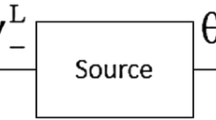Abstract
Our conscious minds exist in the Universe, therefore they should be identified with physical states that are subject to physical laws. In classical theories of mind, the mental states are identified with brain states that satisfy the deterministic laws of classical mechanics. This approach, however, leads to insurmountable paradoxes such as epiphenomenal minds and illusionary free will. Alternatively, one may identify mental states with quantum states realized within the brain and try to resolve the above paradoxes using the standard Hilbert space formalism of quantum mechanics. In this essay, we first show that identification of mind states with quantum states within the brain is biologically feasible, and then elaborating on the mathematical proofs of two quantum mechanical no-go theorems, we explain why quantum theory might have profound implications for the scientific understanding of one’s mental states, self identity, beliefs and free will.
Similar content being viewed by others
References
Alter O, Yamamoto Y (2001) Quantum measurement of a single system. Wiley, New York
Baianu IC (1971) Organismic supercategories and qualitative dynamics of systems. Bull Math Biophys 33(3):339–354
Baianu IC (2006) Robert Rosen’s work and complex systems biology. Axiomathes 16(1):25–34
Baianu IC (2007) Categorical ontology of levels and emergent complexity: an introduction. Axiomathes 17(3):209–222
Baianu IC, Brown R, Glazebrook JF (2007) Categorical ontology of complex spacetime structures: the emergence of life and human consciousness. Axiomathes 17(3):223–352
Baianu IC, Glazebrook JF, Brown R (2011) Quantum symmetries, operator algebra and quantum groupoid representations: paracrystalline systems, topological order, supersymmetry and global symmetry breaking. Int J Res Rev Appl Sci 9(2):163–206
Beck F, Eccles JC (1992) Quantum aspects of brain activity and the role of consciousness. Proc Natl Acad Sci USA 89(23):11357–11361
Bell JS (1966) On the problem of hidden variables in quantum mechanics. Rev Mod Phys 38(3):447–452
Bode S, He AH, Soon CS, Trampel R, Turner R, Haynes J-D (2011) Tracking the unconscious generation of free decisions using ultra-high field fMRI. PLoS One 6(6):e21612
Born M (1926) Zur Quantenmechanik der Stoßvorgänge. Zeitschrift für Physik 37(12):863–867
Busch P (1997) Is the quantum state (an) observable? In: Cohen RS, Horne M, Stachel J (eds) Potentiality, entanglement and passion-at-a-distance: quantum mechanical studies for Abner Shimony, vol 2. Kluwer, Dordrecht, pp 61–70
Cattell JM (1886a) The time taken up by cerebral operations. Parts I–II. Mind 11:220–242
Cattell JM (1886b) The time taken up by cerebral operations. Part III. Mind 11:377–392
Cattell JM (1887) The time taken up by cerebral operations. Part IV. Mind 11:524–538
Cattell JM (1890) Mental tests and measurements. Mind 15:373–381
Chalmers DJ (1995) Facing up to the problem of consciousness. J Conscious Stud 2(3):200–219
Dieks D (1982) Communication by EPR devices. Phys Lett A 92:271–272
Elga A (2004) Defeating Dr. Evil with self-locating belief. Philos Phenomenol Res 69:383–396
Exner S (1873) Experimentelle Untersuchung der einfachsten psychischen Processe I Die persönliche Gleichung. Pflügers Archiv Eur J Physiol 7(1):601–660
Exner S (1874) Experimentelle Untersuchung der einfachsten psychischen Processe II Ueber Reflexzeit und Rückenmarksleitung. Pflügers Archiv Eur J Physiol 8(1):526–537
Exner S (1875) Experimentelle Untersuchung der einfachsten psychischen Processe III Der persönlichen Gleichung zweiter Theil. Pflügers Archiv Eur J Physiol 11(1):403–432
Feser E (2007) Philosophy of mind: a beginner’s guide. Oneworld, Oxford
Frankfurt H (1969) Alternate possibilities and moral responsibility. J Philos 66(23):829–839
Georgiev DD (2004) Consciousness operates beyond the timescale for discerning time intervals: implications for Q-mind theories and analysis of quantum decoherence in brain. Neuroquantology 2(2):122–145
Georgiev DD (2011) A linkage of mind and brain: Sir John Eccles and modern dualistic interactionism. Biomed Rev 22:81–84
Georgiev DD, Glazebrook JF (2006) Dissipationless waves for information transfer in neurobiology—some implications. Informatica (Slovenia) 30(2):221–232
Georgiev DD, Glazebrook JF (2007) Subneuronal processing of information by solitary waves and stochastic processes. In: Lyshevski SE (ed) Nano and molecular electronics handbook. CRC Press, USA, pp 17-1–17-41
Georgiev DD, Glazebrook JF (2012) Quasiparticle tunneling in neurotransmitter release. In: Goddard III WA, Brenner D, Lyshevski SE, Iafrate GJ (eds) Handbook of nanoscience, engineering, and technology, 3rd edn. CRC Press, Boca Raton, pp 983–1016
Hassabis D, Chu C, Rees G, Weiskopf N, Molyneux PD, Maguire EA (2009) Decoding neuronal ensembles in the human hippocampus. Curr Biol 19:546–554
Haynes JD, Sakai K, Rees G, Gilbert S, Frith C, Passingham RE (2007) Reading hidden intentions in the human brain. Curr Biol 17:323–328
Heisenberg W (1925) Über quantentheoretische Umdeutung kinematischer und mechanischer Beziehungen. Zeitschrift für Physik 33(1):879–893
Held C (2012) The Kochen–Specker theorem. In: Zalta EN, Nodelman U, Allen C (eds) Stanford encyclopedia of philosophy. Stanford University, Stanford
Hilgevoord J, Uffink J (2012) The Uncertainty Principle. In: Zalta EN, Nodelman U, Allen C (eds) Stanford encyclopedia of philosophy. Stanford University, Stanford
Hirsh IJ, Sherrick Jr CE (1961) Perceived order in different sense modalities. J Exp Psychol 62(5):423–432
Huxley TH (1874) On the hypothesis that animals are automata, and its history. Fortn Rev 16:555–580
James W (1879) Are we automata? Mind 4(13):1–22
James W (1890) The principles of psychology. Holt, New York
Kanabus M, Szelag E, Rojek E, Pöppel E (2002) Temporal order judgement for auditory and visual stimuli. Acta Neurobiol Exp 62(4):263–270
Kay KN, Naselaris T, Prenger RJ, Gallant JL (2008) Identifying natural images from human brain activity. Nature 452:352–355
Koch C, Hepp K (2006) Quantum mechanics in the brain. Nature 440:611–612
Kochen SB, Specker EP (1967) The problem of hidden variables in quantum mechanics. J Math Mech 17(1):59–87
Lewis PJ (2006) Conspiracy theories of quantum mechanics. Br J Philos Sci 57(2):359–381
McCrone J (2003) Quantum mind. Lancet Neurol 2:450
Nagel T (1974) What is it like to be a bat? Philos Rev 83(4):435–450
Olson ET (2012) Personal Identity. In: Zalta EN, Nodelman U, Allen C (eds) Stanford encyclopedia of philosophy. Stanford University, Stanford
Pati AK, Braunstein SL (2000) Impossibility of deleting an unknown quantum state. Nature 404:164–165
Penrose R (1989) The emperor’s new mind: concerning computers, minds and the laws of physics. Oxford University Press, Oxford
Pitowsky I (2005) Quantum mechanics as a theory of probability. In: Demopoulos W, Pitowsky I (eds) Festschrift for Jeffrey Bub. Kluwer, Dordrecht. http://arxiv.org/abs/quant-ph/0510095
Pöppel E (1997) A hierarchical model of temporal perception. Trends Cogn Sci 1(2):56–61
Popper KR (2002) The logic of scientific discovery. Routledge, London
Popper KR, Eccles JC (1984) The self and its brain: an argument for interactionism. Routledge, London
Robinson W (2012) Epiphenomenalism. In: Zalta EN, Nodelman U, Allen C (eds) Stanford encyclopedia of philosophy. Stanford University, Stanford
Schrödinger E (1926) An undulatory theory of the mechanics of atoms and molecules. Phys Rev 28(6):1049–1070
Seife C (2000) Cold numbers unmake the quantum mind. Science 287(5454):791
Smith K (2011) Taking aim at free will. Nature 477(7362):23–25
Soon CS, Brass M, Heinze H-J, Haynes J-D (2008) Unconscious determinants of free decisions in the human brain. Nat Neurosci 11(5):543–545
Susskind L (2012) The theoretical minimum: quantum mechanics. Stanford Continuing Studies. Stanford. http://www.youtube.com/playlist?list=PL701CD168D02FF56F
Tegmark M (2000) Importance of quantum decoherence in brain processes. Phys Rev E 61(4):4194–4206
Vedral V, Plenio MB (1998) Basics of quantum computation. Prog Quantum Electron 22:1–39
Wegner DM (2002) The illusion of conscious will. The MIT Press, Cambridge
Wigner E (1961) Remarks on the mind–body problem. In: Good IJ (ed) The scientist speculates. Heinemann, London, pp 284–302
Wootters WK, Zurek WH (1982) A single quantum cannot be cloned. Nature 299:802–803
Yu S, Nikolić D (2011) Quantum mechanics needs no consciousness. Annalen der Physik 523(11):931–938
Author information
Authors and Affiliations
Corresponding author
Rights and permissions
About this article
Cite this article
Georgiev, D. Quantum No-Go Theorems and Consciousness. Axiomathes 23, 683–695 (2013). https://doi.org/10.1007/s10516-012-9204-1
Received:
Accepted:
Published:
Issue Date:
DOI: https://doi.org/10.1007/s10516-012-9204-1




